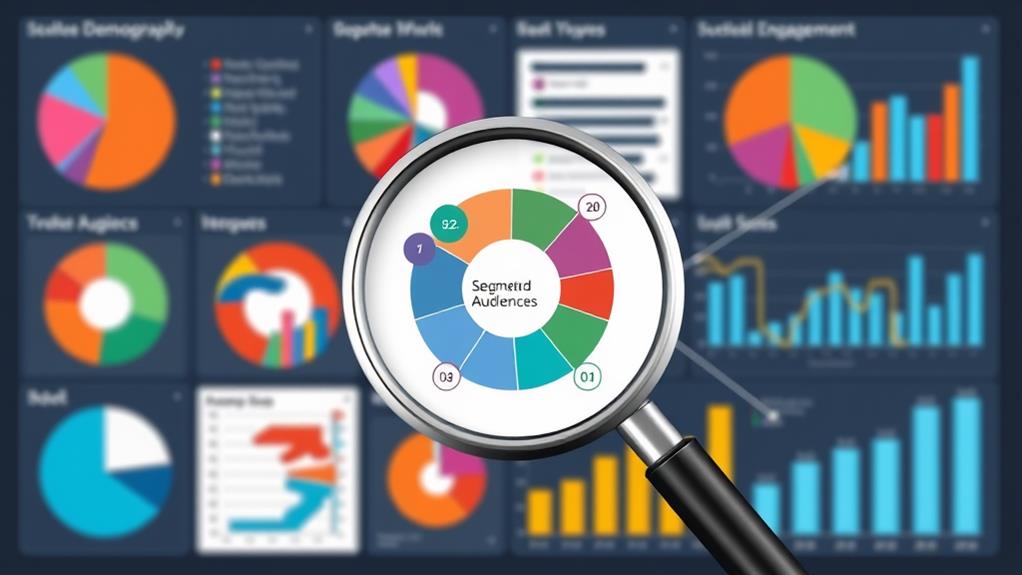Adjusting your social media strategy based on analytics involves leveraging key metrics like engagement rates, reach, and conversion rates to refine content and optimize performance. Using tools like Facebook Audience Insights and Twitter Analytics, identify audience behavior and preferences to tailor your content strategically. Set SMART goals to guarantee your objectives are specific, measurable, achievable, relevant, and time-bound. Regularly monitor performance, address feedback, and move beyond vanity metrics to focus on actionable insights. This strategy fosters continuous improvement and alignment with business goals. Further insights and detailed steps can drive significant advancements in your social media approach.
Key Takeaways
- Analyze engagement rates to identify and promote content that resonates with your audience.
- Use demographic insights to tailor content for your target audience's preferences.
- Monitor conversion rates to adjust strategies and improve the effectiveness of calls-to-action.
- Employ competitive analysis to identify gaps in your strategy and capitalize on opportunities.
- Regularly review and refine goals using SMART criteria to ensure they remain relevant and achievable.
Understanding Social Media Analytics
Understanding social media analytics is essential for any business aiming to refine its digital marketing strategy. The ability to collect and interpret data from platforms like Facebook, Instagram, and Twitter provides a strategic advantage. Effective use of analytics encompasses data privacy, ensuring audience trust while maneuvering through algorithm changes that can impact performance metrics.
For instance, leveraging tools like Facebook Audience Insights allows businesses to gain detailed demographic data and user behavior insights, aiding in targeted content creation.
Analyzing visual metrics and engagement strategies allows businesses to tailor content optimization to specific audience segments. This targeted approach enhances engagement and conversion rates, leveraging the vast data pool from over 4.95 billion social media users.
Competitive analysis becomes more precise when businesses understand channel differences and user feedback, enabling them to outmaneuver rivals.
Contextual analysis is vital, as external factors and platform algorithms can influence engagement metrics. Understanding the "why" behind data trends allows for accurate trend forecasting and strategic decision-making.
By incorporating insights from user feedback, businesses can refine their content and engagement strategies, ensuring they resonate with their target audience.
Moreover, content optimization and competitive analysis are not just about boosting metrics; they play a key role in maintaining audience trust and adhering to data privacy norms.
Strategic use of social media analytics can consequently lead to improved financial performance and higher customer satisfaction levels.
Importance of Analytics
The strategic importance of leveraging social media analytics lies in its capacity to enable data-driven decision-making, empowering businesses to refine their marketing strategies based on real-time trends.
For instance, tools like Twitter Analytics provide detailed data on tweet performance, audience engagement, and profile growth, which helps in tailoring content to increase engagement.
With the ability to continuously monitor user interactions and engagement metrics, organizations can swiftly adapt to emerging patterns and preferences, enhancing their ability to meet customer needs effectively.
This real-time analysis not only improves customer satisfaction but also drives financial performance by ensuring marketing efforts are precisely targeted and optimized.
Data-Driven Decision Making
In the domain of social media marketing, data-driven decision making stands as a vital component for businesses aiming to enhance their online presence and engagement. By leveraging data visualization and predictive analytics, companies can meticulously analyze audience engagement metrics, such as likes, comments, and shares, to tailor content that resonates with specific demographic segments.
This strategic approach not only heightens marketing effectiveness but also leads to tangible benefits; businesses utilizing social media analytics report an average 20% increase in customer satisfaction and a 15% improvement in financial performance.
Understanding the context behind engagement metrics is essential for avoiding misleading conclusions. For instance, spikes in likes or comments may be influenced by external factors or specific audience behaviors. Analytics tools offer deep insights into these patterns, enabling marketers to identify high-performing content types and optimize campaigns for enhanced reach and conversion rates.
Regularly reviewing and adjusting social media goals based on data insights fosters a culture of continuous improvement. This guarantees that marketing efforts stay aligned with evolving audience preferences and market trends, maximizing the impact of social media strategies.
Real-Time Trend Analysis
Amid the rapidly evolving landscape of social media, real-time trend analysis emerges as a critical tool for businesses aiming to stay ahead of audience preferences and behaviors. Leveraging the insights from the 4.95 billion global social media users, businesses can considerably enhance audience engagement by swiftly responding to shifts in interests and behaviors.
Real-time trend identification is facilitated by tools like Google Analytics and various social media management platforms. These tools allow companies to monitor trending topics and sentiment, enabling immediate content adjustments to improve relevance and reach. By continuously evaluating engagement metrics, brands can identify which content resonates most with their audience, fostering a data-driven approach to content creation that aligns with current trends.
| Metric | Importance | Actionable Insight |
|---|---|---|
| Trending Topics | High | Adjust content to align with trends |
| Sentiment Analysis | Critical | Modify messaging to maintain favor |
| Engagement Rates | Essential | Focus on high-performing content |
| Crisis Detection | Immediate | Mitigate negative fallout quickly |
| Customer Feedback | Valuable | Enhance brand loyalty |
Real-time analytics also aids in crisis management by detecting negative sentiment early, allowing brands to adjust their messaging strategies swiftly. Companies that actively analyze trends and audience sentiment report considerably higher customer satisfaction rates, ultimately enhancing brand loyalty through timely and relevant interactions.
Setting Goals and Objectives
Effective social media strategies begin with defining clear objectives that align with organizational goals, leveraging the SMART criteria to guarantee these objectives are Specific, Measurable, Achievable, Relevant, and Time-bound.
By setting precise targets, such as increasing brand awareness by a defined percentage within a specified period, marketers can track progress and maintain accountability.
This structured approach enables data-driven decision-making, guaranteeing content creation and audience targeting efforts remain focused and impactful.
Regular reviews and continuous optimization based on performance metrics further enhance strategy effectiveness.
Define Clear Objectives
Establishing clear objectives for your social media strategy is vital for guiding efforts and measuring success, and utilizing the SMART criteria guarantees these goals are specific, measurable, achievable, relevant, and time-bound.
Goal alignment is essential, as it ensures that your social media objectives complement broader business aims, such as increasing conversion rates or enhancing audience engagement.
To effectively set these objectives, consider the following steps:
- Identify Key Metrics: Focus on metrics that directly align with your business goals, like follower growth or interaction rates.
- Document KPIs: Define key performance indicators to track progress and make data-driven adjustments.
- Review and Adjust: Regularly analyze performance data to refine objectives, making sure they remain relevant and attainable.
- Prioritize Objectives: Rank goals based on their impact on overall business performance and resource availability.
Objective prioritization guarantees that resources are allocated efficiently, maximizing the potential for successful outcomes.
For example, an initial goal might be to increase brand awareness by 20% within six months. By regularly reviewing analytics, this goal can be adjusted to better resonate with audience engagement patterns, thereby optimizing your social media strategy for sustained growth and impact.
Utilize SMART Criteria
Setting clear objectives is just the starting point; leveraging the SMART criteria guarantees these goals are both actionable and impactful. SMART Goals—specific, measurable, achievable, relevant, and time-bound—form the backbone of an effective social media strategy.
Begin by establishing specific goals, such as increasing followers by 20% within six months to enhance brand awareness. This clarity of purpose directs all subsequent actions and resource allocations.
Measurability is essential. Track progress through performance metrics like engagement rates, reach, and conversion rates. These data points provide a quantitative basis for evaluating the efficacy of your efforts, enabling data-driven decisions.
Achievable objectives should align with your current resources and capabilities. Setting realistic targets maintains motivation and avoids the pitfalls of overreaching.
Relevance guarantees your social media goals dovetail with broader business objectives, such as launching a new product or entering a new market. This alignment fosters cohesive strategies that amplify overall business impact.
Identifying Key Metrics
Understanding the importance of key metrics is essential for refining your social media strategy. By focusing on the right performance benchmarks, you can tailor your engagement strategies to meet your business goals more effectively.
Data interpretation aids in understanding audience resonance with content, which is critical for making informed adjustments. Additionally, detailed follower demographics can inform content tailoring for target audiences.
- Engagement Rate: This metric measures the level of interaction users have with your content relative to total reach. It provides insightful data on how effective your content is in capturing and maintaining audience interest.
- Impressions and Reach: These metrics assess the visibility of your posts. Tracking them helps determine whether your audience is adequately exposed to your content and if changes are needed to boost exposure.
- Conversion Rates: Important for linking social media efforts to business outcomes, conversion rates reflect the percentage of users taking desired actions post-engagement. This metric is essential for understanding the direct impact of your social media activities on business goals.
- Click-Through Rates (CTR): CTR gauges how effectively your posts drive traffic to your website. Analyzing CTR helps identify which types of content resonate most with your audience, guiding future content creation efforts.
Choosing Analytics Tools

Selecting the right analytics tools is crucial for optimizing your social media strategy, with criteria such as integration capabilities, customizable reporting features, and audience insights playing pivotal roles.
Tools like Google Analytics, Sprout Social, and Hootsuite offer distinct functionalities that cater to varied business needs, while thorough platforms like Sprinklr enhance data integration and analytical depth.
For instance, tools such as Sprout Social provide advanced analytics for social media engagement and post effectiveness.
Regularly updating your toolset based on evolving trends guarantees your strategy remains data-driven and effective.
Tool Selection Criteria
To effectively choose analytics tools that will enhance your social media strategy, it is vital to prioritize solutions that align seamlessly with your specific business objectives. Identifying the right tools requires a rigorous evaluation of several key criteria to guarantee they provide the necessary data to inform your strategy effectively.
- Tool Functionality: Assess whether the tool offers the features you need, such as intuitive dashboards and customizable reporting options. This functionality is essential for facilitating easier data interpretation and quicker decision-making.
- Data Visualization: Prioritize tools that excel in data visualization, as visually compelling dashboards can help distill complex data into actionable insights, making it easier to track and analyze engagement rates, audience demographics, and competitor insights.
- Comprehensive Metrics: Verify the tool covers all critical aspects of your social media performance. Metrics such as engagement rates, audience demographics, and competitor insights should be readily available to provide a holistic view of your social media strategy.
- Scalability: Consider the scalability of the analytics tools. They should be capable of growing with your business needs and accommodating increased data complexity over time, guaranteeing long-term viability.
Integration With Platforms
Integrating analytics tools with social media platforms is a cornerstone of a robust social media strategy. Selecting the right tools, such as Sprout Social or Google Analytics, is critical for achieving seamless analytics integration. These tools allow for the aggregation of social media data with broader marketing metrics, enabling thorough insights into overall performance.
When evaluating platform compatibility, prioritize analytics solutions that offer intuitive dashboards and customizable reporting options. Such features facilitate tailored data visualization, ensuring the metrics align with your specific business needs.
Tools like Hootsuite and Buffer not only streamline the scheduling and publishing process but also enhance the efficiency of performance tracking and data collection.
Additionally, an effective analytics tool should seamlessly aggregate data across multiple social media platforms. This capability is essential for attaining a complete understanding of audience engagement and the effectiveness of your content.
The integration of competitor analysis features within these tools can further refine your strategy by identifying gaps and uncovering opportunities for improvement.
Reporting Features Overview
Understanding the reporting features of analytics tools is vital for a data-driven social media strategy. Choosing the right tools can greatly enhance your ability to extract valuable insights and optimize your social media performance.
Prioritize tools with intuitive dashboards and customizable reporting options to easily access key metrics and insights. Here are key features to take into account:
- Customizable Dashboards: Tools like Sprout Social and Hootsuite offer customizable dashboards that integrate social media data with overall performance metrics, providing an all-encompassing analysis across multiple platforms.
- Native Reporting Features: Platforms such as Instagram Insights and Facebook Analytics offer native reporting features that yield immediate data without the need for third-party software, streamlining the analysis process.
- Competitor Benchmarking: Select tools that enable competitor analysis, which helps you benchmark your performance against industry standards and identify gaps in your strategy. This feature is essential for maintaining a competitive edge.
- Regular Reporting: Confirm your chosen tools offer regular reporting features, such as scheduled updates and visual representations of data, to track progress and make informed adjustments to your social media strategy.
Analyzing Your Audience
Analyzing Your Audience
Effective social media strategies hinge on a deep understanding of your audience, which starts with thorough demographic analysis. Gathering detailed audience demographics, such as age, gender, location, and interests, enables the creation of extensive customer personas. These personas are critical for tailoring content strategies that resonate with your target audience. Tools like Google Analytics and Facebook Ads offer robust insights into audience engagement trends, facilitating the optimization of content timing and delivery to maximize impact.
Continuous analysis of audience behavior is essential for identifying preferences and emerging trends. By closely monitoring metrics such as likes, shares, comments, and overall engagement, marketers can refine their content strategies to better align with audience expectations. This data-driven approach guarantees that marketing messages are both relevant and compelling, driving higher engagement rates.
Additionally, follower demographics and growth trends can inform content alignment with audience interests, enabling more targeted and effective marketing efforts.
Additionally, leveraging feedback and engagement metrics helps in pinpointing areas for improvement, offering opportunities to enhance the overall customer experience. Regularly updating these insights allows for dynamic adjustments in strategy, keeping content fresh and engaging.
Audience Segmentation

Audience segmentation, a critical component of any robust social media strategy, involves categorizing your audience into distinct groups based on key demographic factors such as age, gender, location, and interests. This approach is essential for tailoring content and marketing strategies to different groups, greatly enhancing engagement effectiveness.
Leveraging analytics tools to gather and analyze audience data allows marketers to identify audience behavior and engagement patterns. This enables them to adjust content timing and delivery for maximum impact.
Key segmentation strategies include:
- Market Research: Conducting thorough market research to understand demographic trends and customer insights.
- Customer Insights: Developing detailed customer personas to create personalized marketing efforts.
- Engagement Tactics: Continuously analyzing segmented audience behavior to refine strategies and adapt to shifting preferences.
- Content Relevance: Ensuring content remains relevant to specific audience segments to improve conversion rates and customer satisfaction.
Research indicates that effective audience segmentation can lead to more personalized marketing efforts, potentially increasing engagement rates by up to 74%.
Creating Targeted Content
Crafting targeted content is pivotal for maximizing the effectiveness of a social media strategy. Leveraging audience segmentation techniques enables marketers to tailor messaging strategies based on demographic insights such as age, gender, and location. This segmentation fosters content personalization, enhancing content relevance and driving higher engagement rates.
Analyzing engagement patterns through social media analytics is essential for identifying ideal posting times. This behavioral analysis guarantees that targeted content reaches the intended audience when they are most active, thereby maximizing visibility and interaction. Utilizing these insights allows marketers to develop creative approaches that resonate specifically with different audience segments, increasing the likelihood of shares and interactions.
For example, refining story posting times by experimenting with various times can help identify peak activity hours, as highlighted in interactive engagement tactics.
Tracking performance metrics, such as click-through rates and conversions, provides actionable insights for refining future content strategies. By understanding audience motivations through these metrics, marketers can adjust their messaging strategies to better align with the preferences and behaviors of their target audience.
Incorporating these data-driven strategies guarantees that content remains relevant and engaging, ultimately fostering stronger connections with the audience. Through a combination of segmentation techniques and ongoing behavioral analysis, marketers can continually enhance their engagement tactics, guaranteeing that their social media strategy remains effective and aligned with evolving audience needs.
Testing and Iteration

Embracing a culture of testing and iteration is paramount for refining a social media strategy. By engaging in content experimentation, marketers can discern the types of posts, ideal posting times, and messaging strategies that truly resonate with their audience. This approach allows for agile responses to shifting social media trends and guarantees continuous relevance.
Additionally, leveraging TikTok analytics tools can provide valuable insights into audience behavior and preferences, enabling a more targeted approach.
To effectively implement testing and iteration, consider the following steps:
- Experiment with Content Types: Diversify your content by testing various formats such as videos, infographics, and blog posts to gauge audience response.
- Enhance Posting Times: Analyze engagement metrics to determine the best times to post and continually adjust based on audience activity patterns.
- A/B Testing: Use A/B testing for specific posts or ads to identify which elements (e.g., headlines, visuals) drive better performance.
- Iterate Based on Analytics: Regularly review performance metrics like engagement and conversion rates to refine and enhance your strategy.
Data-driven insights from these tests can lead to significant improvements in key performance indicators. Brands that systematically enhance their strategies can experience up to a 30% increase in engagement.
Flexibility and responsiveness are essential, enabling marketers to adapt and maintain audience interest in a rapidly evolving social media landscape.
Monitoring Performance
Monitoring performance is an integral component of a successful social media strategy, allowing marketers to make informed decisions based on real-time data. Regularly tracking key performance metrics such as engagement rate, reach, and conversion rates is essential for evaluating the effectiveness of your engagement tactics.
Utilizing social media analytics tools like Sprout Social and Google Analytics can provide valuable insights into audience engagement patterns. This data helps identify which types of content resonate most with your audience, facilitating effective content optimization. Additionally, analyzing Story Insights on platforms like Instagram can reveal potential for enhanced brand storytelling through audience engagement trends.
Analyzing the performance of individual posts reveals trends that can be leveraged to optimize future content. By tweaking aspects such as posting times, formats, and messaging based on data insights, you can enhance engagement and reach.
Conducting competitor analysis further benchmarks your performance against industry standards, revealing gaps and opportunities for improvement.
Setting up regular reporting intervals to review analytics data guarantees timely adjustments to your social media strategy. This continuous monitoring allows for rapid adaptation to emerging trends and audience preferences, ensuring that your strategy remains relevant and effective.
Addressing Feedback

Analyzing performance metrics provides a solid foundation for refining social media strategies, but equally important is how brands address feedback from their audience. Negative feedback on social media can serve as a valuable source of constructive criticism, enabling brands to identify areas for improvement and enhance their products or services.
Ignoring consumer complaints can lead to lasting damage to a brand's reputation, with 60% of consumers stating they would stop using a brand after a negative experience. Conversely, proactively engaging with critics and addressing concerns can foster stronger customer relations and improve overall brand reputation.
Additionally, using sentiment analysis alongside traditional metrics like engagement rates can provide deeper insights into audience reactions.
To strategically leverage feedback loops and enhance consumer engagement, brands should:
- Monitor feedback regularly: Use sentiment analysis to track and categorize feedback for actionable insights.
- Respond promptly: Address both positive and negative feedback swiftly to show commitment to customer satisfaction.
- Incorporate feedback into strategy: Use customer input to refine marketing strategies, which 70% of companies report leads to enhanced customer satisfaction.
- Close the loop: Follow up with consumers to inform them of changes made based on their feedback, reinforcing a culture of continuous improvement.
Utilizing feedback effectively allows for the refinement of marketing strategies, greatly impacting marketing effectiveness and ROI.
Moving Beyond Vanity Metrics
Why do likes and follower counts often fall short in providing meaningful insights for brands? Vanity metrics such as these provide a surface-level view of social media performance but lack depth in illustrating true engagement insights and audience behavior.
While a high number of likes might suggest popularity, they do not necessarily indicate content effectiveness or translate to business impact.
To move beyond vanity metrics, brands should focus on actionable insights derived from more substantive metrics. Click-through rates (CTR) and conversion rates are pivotal, as they measure the effectiveness of content in driving desired actions, such as purchases or sign-ups.
These metrics offer a clearer picture of how well social media efforts align with business objectives.
Additionally, engagement metrics like shares and comments are more indicative of audience interest and interaction. They provide valuable feedback on what resonates with users, enabling brands to tailor their content strategies accordingly.
Time spent on site from social media referrals further enriches this understanding, highlighting the depth of user engagement.
Reporting and Communication

Effective reporting and communication of social media analytics are essential for driving strategic decision-making within an organization. Utilizing data visualization techniques such as charts and graphs simplifies complex metrics, making them more accessible and actionable for team members.
To maximize the impact of your social media strategy, consider these key practices:
- Reporting Frequency: Establish a consistent schedule, like weekly or monthly, for performance tracking. This regularity helps identify trends and facilitates timely strategy adjustments.
- Dashboard Creation: Use tools like Google Data Studio to create customizable dashboards. These provide real-time updates and enhance the clarity of your communication strategies.
- Insights Sharing: Distribute analytics reports across relevant departments to foster team collaboration. Sharing insights guarantees all teams are aligned on goals and strategies.
- Analytics Transparency: Maintain transparency in reporting to build trust and confirm that decisions are data-driven and strategic.
Effective communication strategies should involve clear, concise reporting methods that align with overall marketing goals.
Frequently Asked Questions
How Do You Use Analytics to Inform Your Social Media Strategy?
Analytics inform your social media strategy by providing critical insights into engagement metrics and audience demographics. By analyzing this data, you tailor content to resonate with specific segments, optimize posting schedules, and refine strategies for improved interaction and conversions.
How Do You Manage Social Media Analytics?
Managing social media analytics involves leveraging data visualization and metric tracking tools to monitor KPIs like engagement, reach, and conversion rates. This strategic approach facilitates informed decision-making and continuous refinement of content and posting strategies.
How Can I Improve My Social Media Strategy?
To improve your social media strategy, focus on audience engagement and content optimization by analyzing key metrics, segmenting audiences, experimenting with formats and times, integrating feedback, and leveraging analytics tools to stay competitive and aligned with industry trends.
What Is the 5 5 5 Social Media Strategy?
The 5 5 5 social media strategy involves posting five educational, five entertaining, and five inspiring pieces of content. This approach leverages engagement metrics and audience demographics to create a balanced, data-driven strategy that maximizes audience interaction.
Conclusion
In summary, leveraging social media analytics is imperative for refining and optimizing social media strategies. By systematically setting goals, identifying key metrics, and employing appropriate analytical tools, organizations can monitor performance effectively. Addressing feedback and moving beyond vanity metrics guarantees a more meaningful engagement with the audience. Extensive reporting and clear communication of findings further bolster strategic decision-making, ultimately enhancing the overall efficacy of social media initiatives. Data-driven approaches consequently remain central to sustained digital success.




